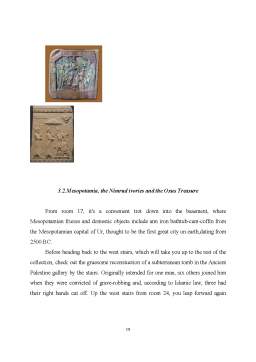Cuprins
- Introduction
- 1. Visiting the British Museum .
- 2. Greek and Roman antiquities
- 2.1. From Prehistoric to Classical Greece
- 2.2. The Harpy Tomb, Bassae frieze and Nereid Monument
- 2.3. The Elgin Marbles
- 2.4. The Tomb of Payava and the Mausoleum of Halicarnassus
- 2.5. The basement galleries: Greek and Roman sculpture
- 2.6. The first-floor galleries
- 3. Western Asiatic antiquities
- 3.1. Assyrian sculpture and relief
- 3.2. Mesopotamia, the Nimrud ivories and the Oxus Treasure
- 4. Egyptian antiquities
- 4.1. The Egyptian Hall
- 4.2. The mummies and other funerary art
- 5. The Prehistoric and Romano-British collection
- 6. The medieval, Renaissance and Modern collections
- 7. The Mexican Gallery
- 8. The Oriental collections
- 8.1. Chinese collection
- 8.2. South East Asian antiquities
- 8.3. The Islamic gallery
- 9. The British Library
- 10. Conclusion
Extras din referat
Introduction
The British Museum is one of the great museums of the world and, after Blackpool Beach, is Britain's most popular tourist attraction (in excess of six million visitors a year). With over four million exhibits-a number increasing daily with the stream of new acquisitions, discoveries and bequests-ranged over two and a half miles of galleries, this is one of largest and most comprehensive collections of antiquities, prints, drawings and books to be housed under one roof.Its collection of Roman and Greek art is unparalleled, its Egypt, and, in addition, there are fabulous tresures from Anglo-Saxon and Roman Britain, from China, Japan, India and Mesopotamia-not to mention an enormous collection of prints and drawings, only a fraction of which can be displayed at any one time.
The origins of the British Museum lie in the collection of over 80,000 curios from plants and fossils to coins and medals-belonging to Sir Hans Sloane, a wealthy Chelsea doctor who bequeathed them in 1753, in return for £ 20,000. His collection was purchased by an unenthusiastic government to form the kernel of the world's first public museum housed in a building bought with the proceeds of a dubiously conducted public lottery. Soon afterwards the British Museum began to acquire the antiquities that have given it a modern reputation as the world's largest museum of stolen goods. The "robberies" of Lord Elgin are only the best known; countless others engaged in sporadic looting throughout the Empire the Napoleonic Wars provided the victorious British with heaps of antiquities pilfered by the French in Egypt and the British museum itself sent out its own archeologists to strip Classical sites bare.
As early as 1820 it was clear thet more space was needed for all this loot, hence the present structure, built piecemeal over the course of the next thirty years. The overall design was by Sir Robert Smirke, whose giant Ionian colonnade and portico, complete with a pediment frieze, make this the grandest of London's Greek Revival buildings. Lack of space has continued to be a problem, however: the natural history collections were transferred to South Kensington in the 1880s, and the ethnographical departament was later rehoused near Piccadilly to become the Museum of Mankind. When the British Library eventually moves to its new premises at St.Pancras, the museum's £ 60 million redevelopment plan aims to bring the ethnographical department back to the British Museum, and to open up Smirke's Great Court around the Round Reading Room of the British Library, which will feature a glass roof designed by Norman Foster.
1. Visiting the British Museum
The British Museum's fourteen-acre site is enough to tire even the most ardent museum lover, J.B.Priestley, for one, wished "there was a little room somewhere in the British Museum that contained only about twenty exhibits and good lighting, easy chairs, and a notice imploring you to smoke". Short of such a place, the best advice is either to see the highlights and leave the rest for another visit, or to concentrate on one or two sections. Alternatively, you might consider one of the British Museum's guided tours, which cover the highlights in around one and a half hours.
There are two entrances (both have cloakrooms): the main one, on Great Russell Street, brings you to the information desk and bookshop, while the smaller doorway on the north side of the building in Montague Place opens onto the Oriental galleries. The information desk will furnish you with a free museum plan, and the noticeboard close by announces which rooms are currently closed. Even equipped with a plan, it's easy enough to get confused-the room numbering is complicated and many sections are spread over more than one floor. It can get crowded,too:if you're heading for the major sights, try to get here as early in the day as possible, and avoid the weekends if you can, when the popular galleries are overrun. It's a far cry from the museum's beginning in 1759 when it was open for just three hours a day, entry was by written application only, and tickets for "any person of decent appearance" were limited to ten per hour.
Preview document
Conținut arhivă zip
- British Museum.doc



















































